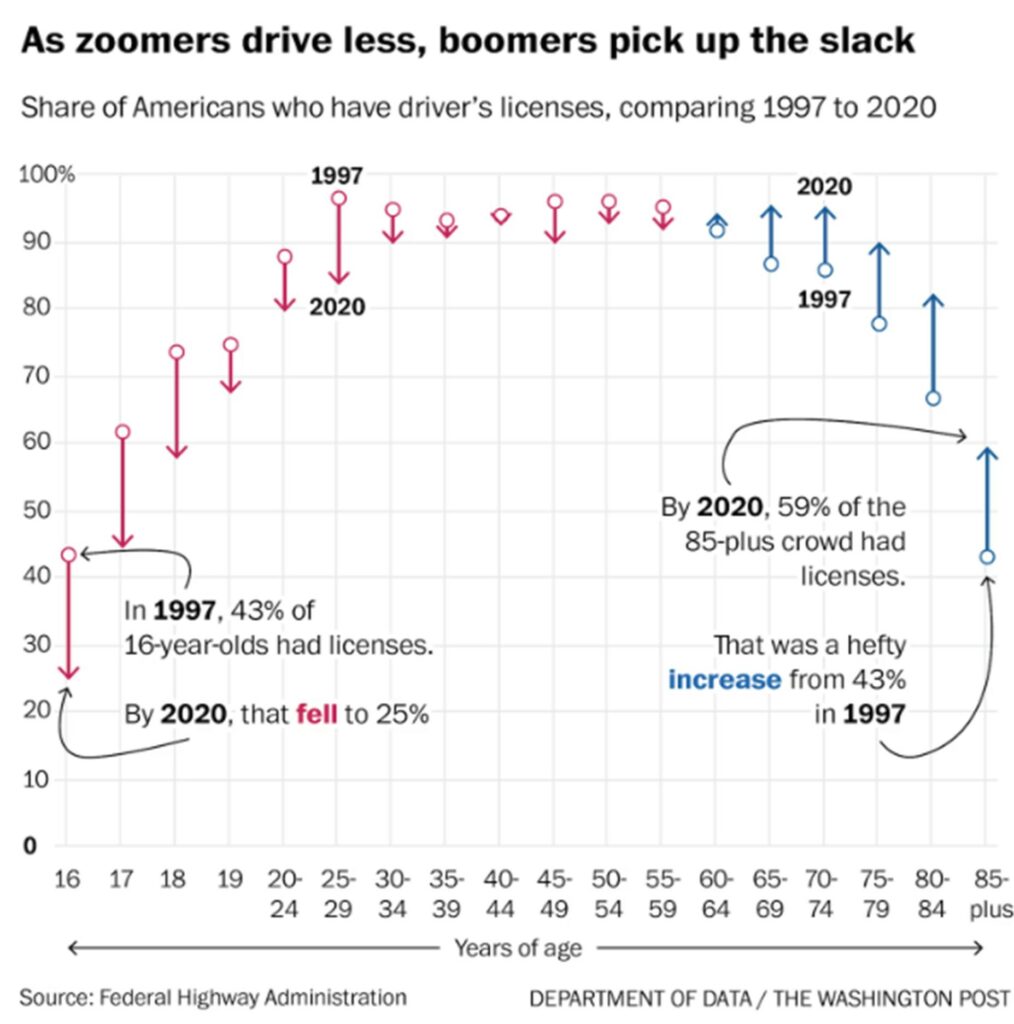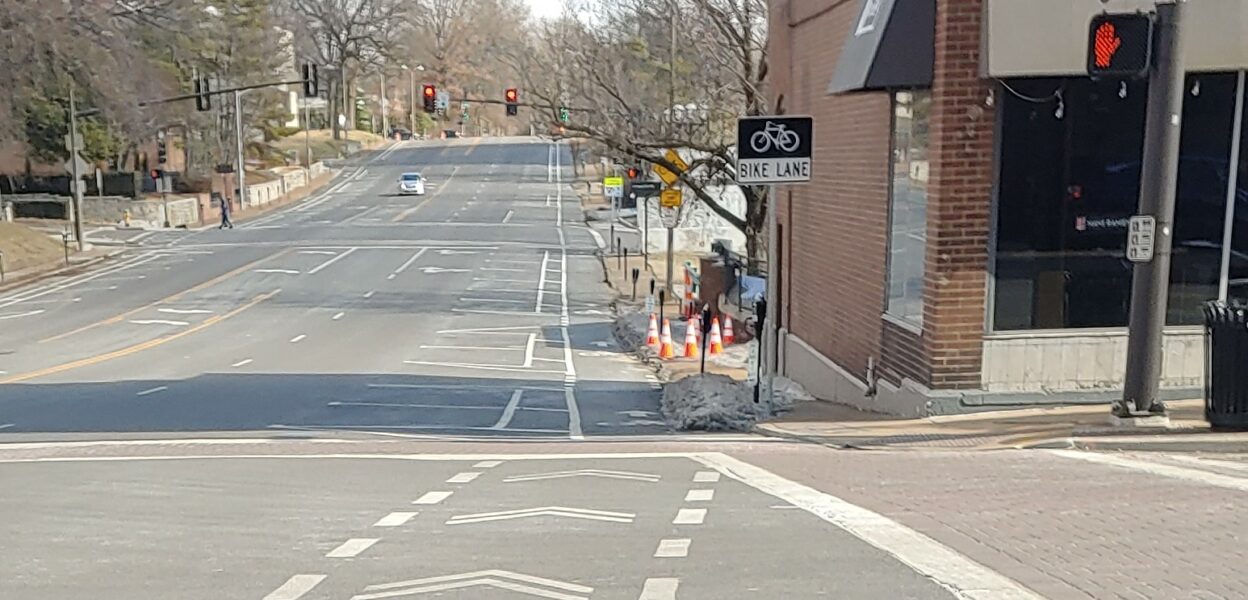America is getting older [1], and American drivers are getting way older [2, Figure below]. This seachange in the demographics of those operating motor vehicles is incredibly important (and, I would argue, underconsidered in the urbanist world).

Older adults driving in complex environments (e.g. complicated traffic patterns, lane changes, turns, and congestion) have a much higher crash risk than the average driver. Older adults are also far more likely to die when involved in an automotive crash due to preexisting comorbidities. The risks associated with driving affect not only these older drivers, but everyone around them.
I study Alzheimer’s Disease at Washington University in St. Louis. One of the ongoing studies at WUSTL is a naturalistic driving study called DRIVES, led by Ganesh Babulal. Participants in the DRIVES study are enrolled in research at the Knight Alzheimer Disease Research Center (ADRC) and consent to having a small data logger placed in their car (very similar to the Progressive Insurance Snapshot Program). Through their participation at the Knight ADRC we collect blood, cerebrospinal fluid, MRI/PET images of their brains and perform cognitive testing. Through their participation in the DRIVES study, we get information sampled every 30 seconds of their lat/lon coordinates and driving speed.
Alzheimer’s Disease is a slowly progressing neurodegenerative disorder. Although (sadly) many of us are familiar with the “clinical manifestations” of this disease – forgetfulness, difficulty with navigation, and progressive decline in cognitive functioning, this disease actually begins much earlier. 15 – 20 years prior to these observable symptoms, things called amyloid plaques are already developing in the brain. Presence of these plaques can be detected with appropriate PET radiotracers, isolated from cerebrospinal fluid, and – as of relatively recently – with blood.
Prior research has established that cognitively normal drivers with amyloid plaques in the brain exhibit many changes in driving behavior, including: less aggressive driving behavior, smaller driving space, less seatbelt use, late responses to changes in the driving environment, more driving errors on road tests, and reduced driving speeds [3 – 8]. Driving behaviors are so characteristically modified by the presence of amyloid plaques that one of my colleagues was even able to predict whether or not someone had amyloid in the brain solely from their driving data [6]!
Driving is an incredibly complex task – you have to deal with constantly changing stimuli, adjust to dynamic conditions, engage in navigation and planning, and just generally try not to kill anyone around you. For people with amyloid plaques gunking up their brain, this is particularly hard. The average older adult actually stops driving roughly 7 years prior to death [9] and while hanging up the keys may seem like a positive for road safety, this results in lower social participation and increased isolation and depression [10]. A large body of literature exists arguing that road diets are a key design choice that can be made to increase pedestrian safety for older adults [11 – 12].
Let’s review what we know:
- Older adults are driving at greater rates than generations prior
- Driving is particularly deadly for older adults
- Older adults who cease driving see major degradations in quality of life
- The federal government suggests that complete streets treatments (e.g. road diets) will help protect elderly pedestrians
Reviewing that list leads me to ask – what the heck is our plan for older drivers? If older adults are not getting out of their cars (which, given current land use policies, they kind of can’t), shouldn’t we be curious about what the effect of complete streets will be on the aging driver?
So that’s what we set out to do. We looked for natural experiments – instances where road diets had been implemented at some point during the DRIVES study (2015 – present) where a relatively large number of research participants had driven through the road segment of interest. After doing this, we identified three road diets that we could study: Maryland Ave in Clayton, Pershing Ave in U City, and Natural Bridge Road spanning both St. Louis City and St. Louis County.
NextSTL has already had great detailed coverage of Natural Bridge Road. Cross-Sections of Maryland Ave (which started as a 4 lane road and was transformed into a 3 lane road with parking protected bike lanes) and Pershing Ave (which started as a 4 lane road and was transformed into a 2 lane road with buffered bike lanes) are shown below.




What we found was kind of amazing. Overall, implementing road diets resulted in slower speeds on each of the three streets. We also observed a pattern consistent with the literature – drivers with amyloid plaques in the brain drove more slowly than drivers without. What was surprising, though, was that implementing a road diet caused the healthy (amyloid free) drivers to slow down but there was no slowing of the drivers with amyloid plaques. This differential effect was unexpected, but may help explain why road diets are so frequently associated with major decreases in car crashes – the design of the road forces all drivers to a consistent speed. All drivers are now driving at a rate that feels comfortable to a mildly impaired older adult.
This finding set up the conclusion of our paper: [Road diets] could empower older adults to continue driving while maintaining the safety of other road users both inside and outside of vehicles. Given the current state of the United States’ auto-dependency, lane repurposing could translate into much higher quality of life for older adults without sacrificing the safety of the individuals around them. We recommend that policymakers consider lane reduction solutions to facilitate older adults’ ability to age in place.
As a person who predominantly travels the city by bike, I am a big fan of the parking protected bike lanes on Maryland Ave and Union, and I would love to see more of those. I felt that way before I studied them, but on an academic level – after considering the problems associated with our city layout and aging populace, I am an even bigger fan. I invite the readers of NextSTL to check out the full manuscript, Differential Impacts of Road Diets on Driving Behavior among Older Adults with and without Preclinical Alzheimer’s Pathology which is available at Transportation Research Part F.

